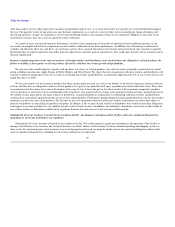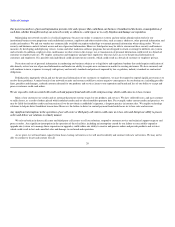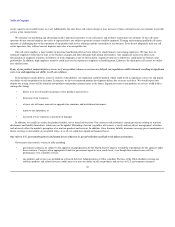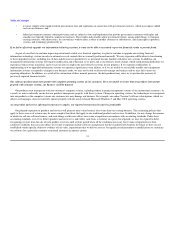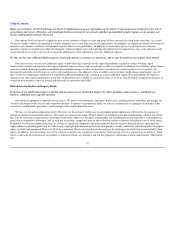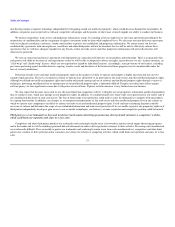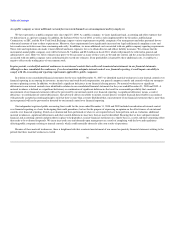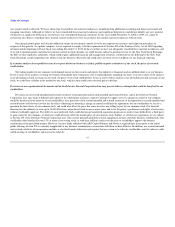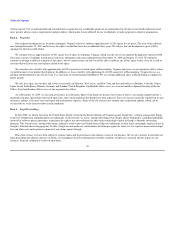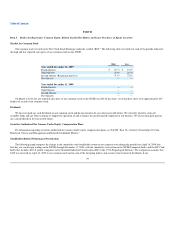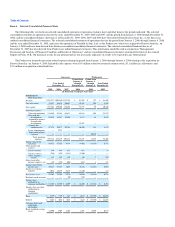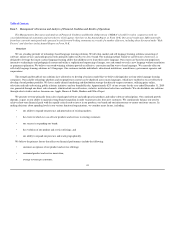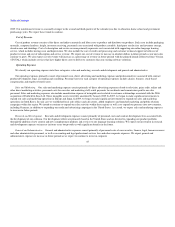Rosetta Stone 2009 Annual Report Download - page 38
Download and view the complete annual report
Please find page 38 of the 2009 Rosetta Stone annual report below. You can navigate through the pages in the report by either clicking on the pages listed below, or by using the keyword search tool below to find specific information within the annual report.
Table of Contents
As a public company we incur additional cost and face increased demands on our management and key employees.
We have operated as a public company only since April 15, 2009. As a public company, we incur significant legal, accounting and other expenses that
we did not incur as a private company. In addition, the Sarbanes-Oxley Act of 2002, as well as rules implemented by the Securities and Exchange
Commission, or SEC, and the New York Stock Exchange, impose various requirements on public companies. Our management and other personnel devote
substantial amounts of time to these requirements. Moreover, these requirements have significantly increased our legal and financial compliance costs and
have made some activities more time-consuming and costly. In addition, we incur additional costs associated with our public company reporting requirements.
These rules and regulations also make it more difficult and more expensive for us to obtain director and officer liability insurance. We estimate that the
incremental annual public company costs will be between $1.5 million and $2.0 million in fiscal 2010, which will primarily be reflected in general and
administrative costs. However, these estimates may prove to be inaccurate as many of these costs are beyond our control, and the actual incremental costs
associated with our public company status could materially exceed our estimates. If our profitability is harmed by these additional costs, it could have a
negative effect on the trading price of our common stock.
In prior periods, we identified material weaknesses in our internal controls that could result in material misstatements in our financial statements.
Although we have remediated the weaknesses, if we do not maintain adequate internal controls over financial reporting, it could impair our ability to
comply with the accounting and reporting requirements applicable to public companies.
In relation to our consolidated financial statements for the year ended December 31, 2007, we identified material weaknesses in our internal controls over
financial reporting in accounting for inventory, income taxes and stock-based compensation, our general computer controls and controls within our enterprise
resources planning system. In addition, we identified a significant deficiency in our financial closing process. No material weaknesses or significant
deficiencies in our internal controls were identified in relation to our consolidated financial statements for the years ended December 31, 2008 and 2009. A
material weakness is defined as a significant deficiency or combination of significant deficiencies that result in a reasonable possibility that a material
misstatement of our financial statements will not be prevented by our internal control over financial reporting. A significant deficiency means a control
deficiency, or combination of control deficiencies, that adversely affects our ability to initiate, record, process or report financial data reliably in accordance
with generally accepted accounting principles such that there is more than a remote likelihood that a misstatement of our financial statements that is more than
inconsequential will not be prevented or detected by our internal control over financial reporting.
Our independent registered public accounting firm's audit for the years ended December 31, 2008 and 2009 included consideration of internal control
over financial reporting as a basis for designing their audit procedures, but not for the purpose of expressing an opinion on the effectiveness of our internal
controls over financial reporting. If such an evaluation had been performed or when we are required to have them perform such an evaluation, additional
material weaknesses, significant deficiencies and other control deficiencies may have been or may be identified. Ensuring that we have adequate internal
financial and accounting controls and procedures in place to help produce accurate financial statements on a timely basis is a costly and time-consuming effort
that needs to be evaluated frequently. We incur increased costs and demands upon management as a result of complying with the laws and regulations
affecting public companies relating to internal controls, which could materially adversely affect our results of operations.
Because of these material weaknesses, there is heightened risk that a material misstatement of our annual or quarterly financial statements relating to the
periods that these material weaknesses existed
36


